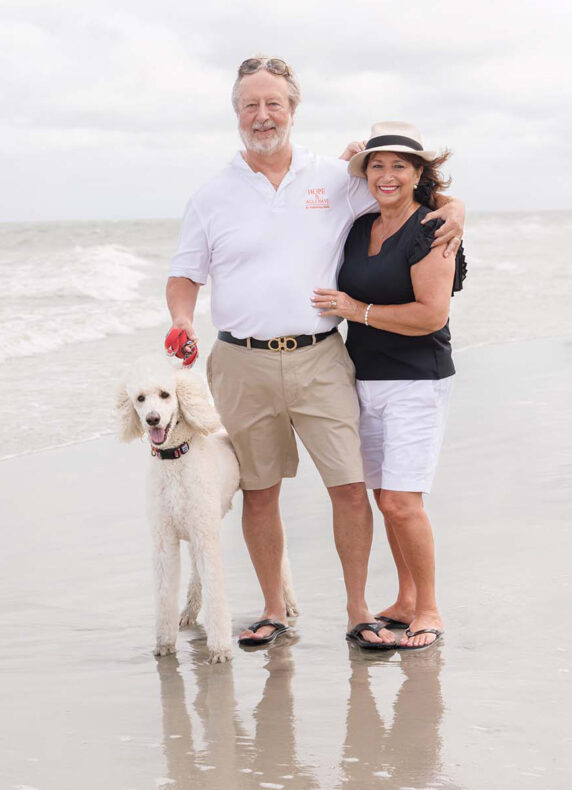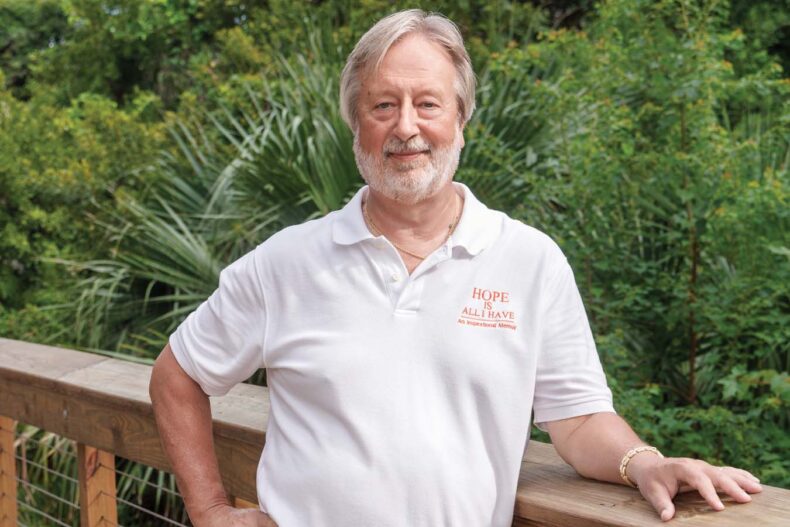In the summer of 2021, I was diagnosed with Stage 4 renal cell carcinoma. Needless to say, my world was turned upside down. Cancer is such a devastating disease, and no one wants to be a part of that club. No preplanning for this one. Yet, there I was, handed this diagnosis with no plan in hand.
“What’s next?” I thought. While the radiologist was giving me some direction on my recent discovery, I totally passed out! “This couldn’t be happening, could it? Look at me, I’m a healthy, physically fit, soon to be retired happy-go-lucky male.” Ironically, in all of this, I just received my very first Social Security deposit earlier that morning. Good luck seeing my next one!
Two weeks later, I was undergoing a serious operation to remove my right kidney and 11 centimeter tumor when the unimaginable happened. Parts of the tumor broke apart during the resection. A loose thrombus from the large tumor traveled up my inferior vena cava and into my heart, which stopped my blood flow for up to 10 minutes. That generally means instant death! Obviously, I didn’t “expire,” as I am here writing this dialogue for you. However, there are many excruciating details of how I ultimately survived that surgery and lived to talk about it. That particular incident and my cancer journey that followed are quite a story. In fact, I authored a bestselling book describing that operation and what really happened in those 10 “lifeless” minutes.
The book recounts that major event along with the six months that followed. It was quite a ride enduring the cancer emotions for both me and my wife along with the continual cancer treatments. My therapy following the operation involved a regimen of pembrolizumab infusions, which is an immunotherapy, along with a daily intake of Inlyta pills, a targeted therapy that inhibits the growth of cancer cells.
After following this schedule for the two years that was prescribed, it was decision time. I had great success with the mix of these two drugs in fighting my cancer, although I encountered many side effects along the way. I was determined to stay the course no matter what the consequences were. Now at this crossroad, I had many options to consider. Keep the medication intake the way it was? Reduce the number of medications? Or a combination of many other variables? After giving this much thought, I asked my oncologist at the Medical University of South Carolina, Dr. Theodore Gourdin, about getting another opinion. Dr. Gourdin was gracious regarding my question and suggested two other oncologists who specialized in kidney cancers. One of the doctors he mentioned was Dr. Brian Rini at Vanderbilt-Ingram Cancer Center in Nashville. I researched Dr. Rini online and felt like he was my guy. After all, he had authored the treatment study that I’d been on for the past two years.
Hollings Cancer Center at the Medical University of South Carolina contacted Vanderbilt-Ingram and introduced me to them in order to get the ball rolling. I followed their introduction with a call to set up an appointment. I was impressed from the moment the receptionist answered the phone. She was very welcoming, and after some discussion she switched me over to Dr. Rini’s navigator who was already familiar with my case. She scheduled an appointment for a Thursday at 10 a.m. That was only 48 hours from the time I was speaking to her.
I would need to step it up as the cancer center was over 500 miles away involving an eight-hour-plus drive. We would have to leave early Wednesday morning to arrive in Nashville at a reasonable hour. Considering that MUSC and VUMC used the same software company, (Epic Systems Corp.), I was able to merge the two systems so Dr. Rini would have immediate access to all my medical records. It was amazing how all of this came together in short order.

My wife, Linda, and I, along with our standard poodle, Gianni, loaded up our SUV Wednesday morning and headed toward Nashville. Ingram Content Group, the company that would print my book on cancer is located in La Vergne, Tennessee, southeast of Nashville. Considering it was along the way, I thought it would be beneficial to stop and see the facility that would ultimately publish my book when it came out. This trip was kind of full circle for me, being that the cancer center that I was heading to was named in honor of the family who made a large contribution to Vanderbilt University Medical Center for the cancer center. This was all very surreal to me in a good way.
We arrived in Nashville on Wednesday evening and checked into a hotel near the Vanderbilt campus. After unpacking, we drove around the college campus and noted the beauty of it all. We found the cancer center and parked our car in the convenient parking garage adjacent to the large glass building. I had Linda take my picture next to the Vanderbilt-Ingram Cancer Center sign located in front. We noticed that they had complimentary valet parking. We thought that was a nice offering, but we would forgo that service the next morning. After finding a good barbecue restaurant that evening, we went to bed with great anticipation for my appointment the next morning.
We woke up early and took Gianni for a nice stroll in the downtown area. Nashville is a very friendly town that displays country music everywhere you look. The downtown atmosphere was relaxing and a joy to walk through. After our short dog walk, we got Gianni situated in our motel room and headed to our appointment with Dr. Rini.
When we walked into the lobby of the cancer center, I immediately noticed the piano situated against the paneled wall of the room. It was a shiny black piano that had a calming appearance to it. It all made sense being we were in Nashville.
The flooring was carpeted, with comfortable seating scattered throughout the spacious room. I took note of the coffeepot on the self-service bar that I thought was a nice touch. It was obvious that Vanderbilt went to great lengths to make its cancer patients feel comfortable while visiting their oncologists. We checked in with the nice lady at the front desk, who entered my information into their system, then we took a seat in the lobby. It was approximately 10 minutes to 10 a.m. when Dr. Rini’s nurse called my name. “That didn’t take long,” I thought. We followed her to the exam room, where she asked a few questions and said that Dr. Rini would be in shortly.
At precisely 10 a.m., Dr. Rini entered the room. He didn’t have a medical chart, laptop computer or anything such as this with him. He was sharply dressed; however, he wasn’t wearing the usual white coat that most doctors wear. This created a much more relaxing atmosphere. We shook hands; he introduced himself; and we all took a seat.
He looked me in the eye and said, “I have studied your case and know it very well. Your situation is very unique, and I’m glad you’re doing so well after a rocky start to your journey.” We jumped into some particulars regarding my nebulous cancer outlook. I was very impressed that he didn’t have to refer to any notes on the topics we discussed. After a 30-minute conversation, we jointly came to a satisfactory conclusion as to how I needed to proceed going forward. As we exited the exam room, Dr. Rini said he would keep up with my progress and to never hesitate to reach out to him if I felt the need to do so. I felt comfort in knowing that.
As I exited the Frances Williams Preston Building, I turned around, took a good look and thought, I know I came to the right place, at the right time, and saw the right doctor. This is probably the most satisfied feeling I’ve had since my cancer diagnosis. To have the validation from this wonderful cancer facility along with the work that my magnificent cancer center in Charleston has already accomplished, I couldn’t be in a better place. I’m very fortunate to have been treated by two outstanding National Cancer Institute-designated Cancer Centers, and my success in fighting this terrible disease will be a reflection of that.
The post A Second Opinion appeared first on VUMC News.



